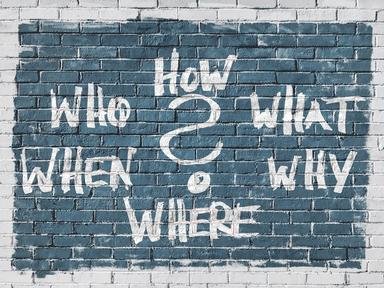Quiz Answer Key and Fun Facts
1. Nothing can be more technical and banal than poetry (I'd say). An 'iamb' occurs when a foot of Classical poetry (two syllables in one line or meter) has one short syllable and one long syllable in succession. In other words 'Ka-Ching!' is iambic because you put strength on the second half, 'Ching!'.
Sonnets are an obvious form of Classical poetry. Each line has ten syllables. It makes sense that if each line consists of iambic feet it is which of the following?
2. Metaphors are like walnuts. They're hard to crack. That's why we'll ignore them for now.
Similes, on the other hand, are a bit easier to spot for most. In fact, I used one in my previous paragraph. How can you tell?
3. Onomatopoeia is a hideous word to spell. Look at all those consecutive vowels! While 'pop' is onomatopoeia, 'radar' is not. Neither is 'walnut'.
Which of these would also be onomatopoeia?
4. "I like walnuts for my lunch/They provide a nutty crunch"
It's simple as that; two poetic lines are there for you to analyze. In fact, I'll save you the trouble. What is the typical term for these simple, rhyming lines of poetry?
5. A good book usually follows a simple pattern of rising and falling action. Let me spoil Charles Dickens' "A Christmas Carol" for you.
In the 'Rising Action', Scrooge meets his three ghouls and follows them through the past, present, and the 'yet to come'.
In the 'Climax', Scrooge visits his own grave and comes to a realization.
During the events of the Falling Action, the story makes its way to the end.
What French word denotes the conclusion of a story?
6. My book is a 'Künstlerroman'. Why even describe it further? This term is akin to a similarly ubiquitous name, 'Bildungsroman', which refers to a narrative in which the main character grows from youth to adulthood.
Since we all know German, and we now know what a 'Bildungsroman' is, what is the definition of 'Künstlerroman'?
7. Okay, so maybe Aldous Huxley and George Orwell were pessimists. Their views of futuristic societies, however different, had one thing in common: they were set in Dystopian societies. Dystopia translates to 'bad place' and when implemented in a work of prose or poetry, it depicts a very unpleasant, bleak world.
What word coined by Thomas More in 1516 refers to the opposite of 'Dystopia'?
8. While we would waste no time in telling people what Alliteration is, those who study English would expect the term to be a pretty common one to remember: words in near-succession beginning with the same letter or sound.
Assonance is different (and no...it's not dirty). Assonance applies to similar vowel sounds in words written next to one another in poetry. "Sweet dreams", for example, has the same 'ee' sound.
What is 'Consonance' in that case?
9. Sonnets, according to some English literature professors, are utterly spectacular. See, the problem with this is that we know better. Let's make this more interesting.
It's a competition now: way back when, which author wrote longer sonnets?
10. Sometimes, the point of view in a narrative poem or story is important to note as it affects the reader's interpretation. A first-person narration means that someone from within the story is the narrator. A third-person narration means that someone who is not named or within the story is narrating.
Is there such thing as a second-person narration?
Source: Author
kyleisalive
This quiz was reviewed by FunTrivia editor
CellarDoor before going online.
Any errors found in FunTrivia content are routinely corrected through our feedback system.

